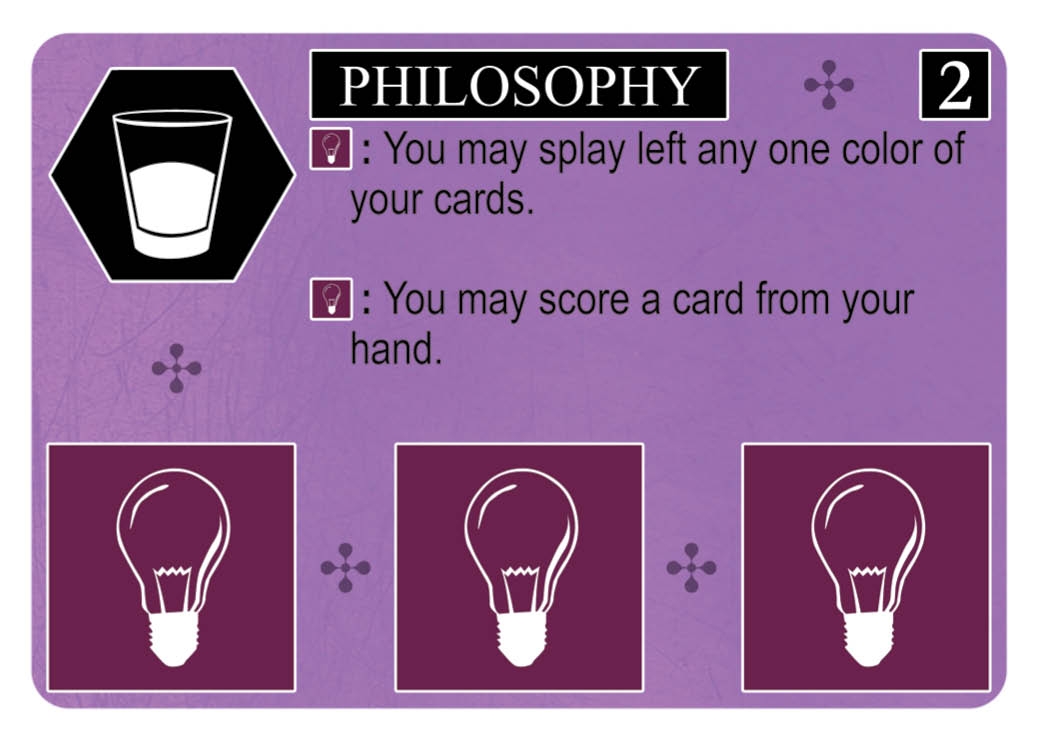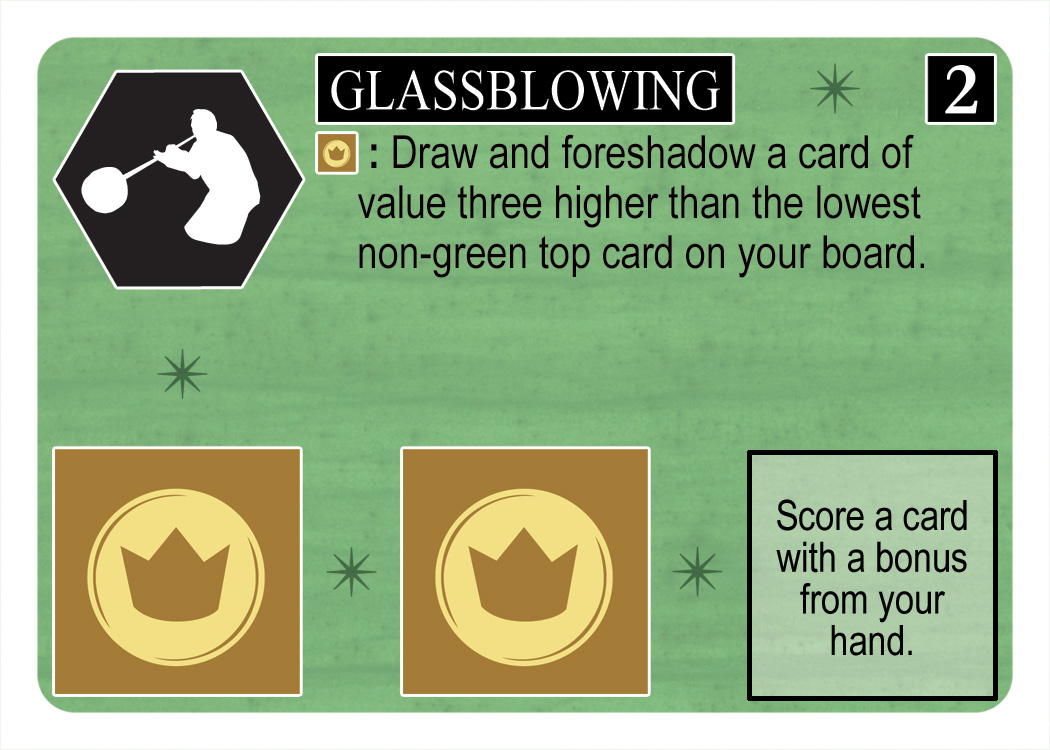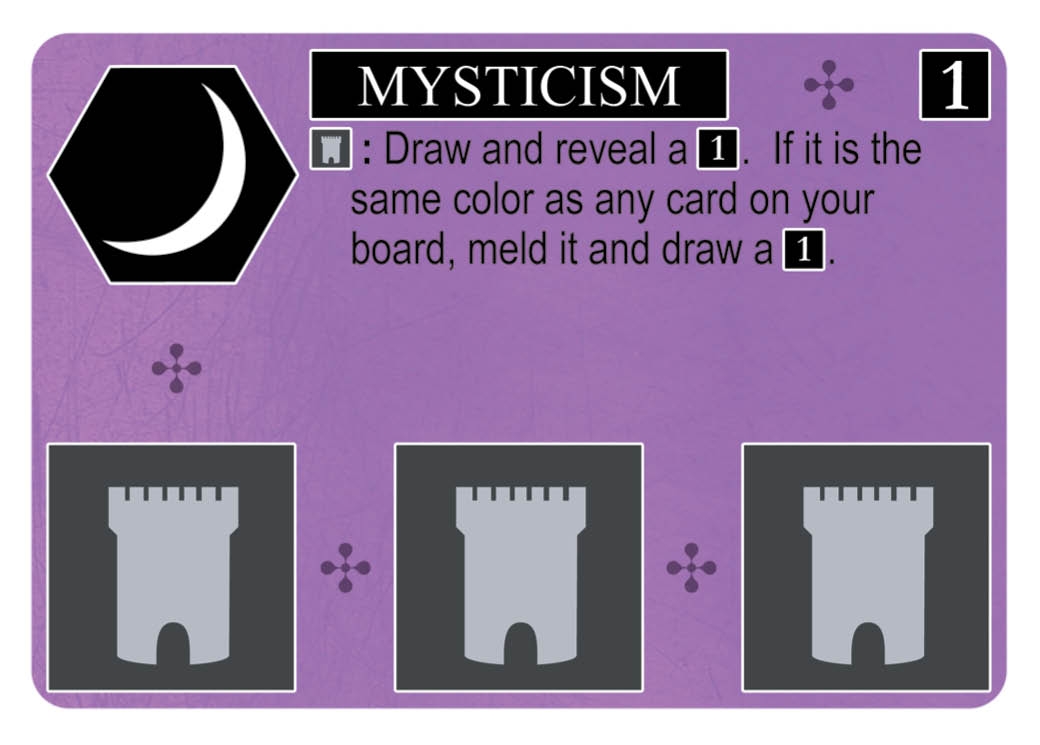Previously:
All cards in Innovation serve some purpose. Some, however, are more powerful in more situations, and others are less powerful in fewer situations.
This ranking attempts to categorize every base Innovation card into four “tiers”. Although every game is unique, and different cards are more important at different times, this ranking considers each card’s average utility in the average 2-player base game. It asks, “How often do I prefer to draw this card, as opposed to my opponent, and how important is that to me?” Sometimes, the most important card for you to draw is Feudalism. Usually, it’s something else.
Top Tier: These are cards to actively seek out because they can form the backbone of your tableau. They are real gamechangers, and almost always either very helpful to you, or very important to deny to your opponent. If the icons permit it, you’d like to use these dogmas as much as you can.
High Tier: These are cards that you are quite happy to draw. They might be a bit more specialized than “top tier” cards, or they might lose their value faster, but they are still important and you would much rather see them on your board instead of your opponent’s. Their dogmas are likely almost always preferable to the basic actions (e.g., drawing), often because they are strictly superior.
Mid Tier: These are solid cards that are OK to meld onto your board, but not part of a long-term plan. Their dogmas aren’t especially powerful, but still better than the basic actions. Mostly they are vehicles to more powerful cards.
Low Tier: These cards are rarely, if ever, useful. Their icons are probably their most redeeming factor, as their dogmas are either extremely specialized or all-around weak, barely better (or sometimes even worse!) than the basic actions. They are the first ones to be returned, and you are probably happy to meld this onto your opponent’s board instead of yours.
Note that not every Age has an equal number of cards in each tier. Within each tier, the cards are only very roughly ordered, as individual circumstances at that point far outweigh the differences in the cards.
Top Tier
Industrialization is probably the most snowbally card in the game. It is a key card in almost every game, either because you want it or you don’t want your opponent to have it. It accomplishes so many things at once:
- It can singlehandedly claim four of the five special achievements (Monument, Empire, Wonder, World)
- It almost assuredly leads to total icon domination, provided you have some other splaying dogmas
- It rapidly clears out the piles, allowing you to catch up in tech or run out the piles if you have a score lead
- And in Echoes, it is just flat-out broken, assuming you have set it up to draw/tuck Echoes cards
Its real drawback is that you aren’t melding anything. Your top cards stay the same, while if your opponent has Atomic Theory, your pile-clearing is letting them get nicer top cards. It also doesn’t give you many icons if you can’t splay any other colors besides red/purple. And it is very dangerous if your opponent also has draw capability and a score lead on you. Nevertheless, even then, you are probably glad you drew it and he didn’t.
Vaccination would be number one in any other age, but here it has to settle for second-best. It’s still by far one of the best score-deniers in the game, and the card every early-scoring strategy dreads. (If you’re way behind in score but have been teching up with Mathematics, it’s often worth it to stop at Age 6 to hunt for Vaccination if you’re in danger of losing.) Your opponent’s “compensation” isn’t even really much compensation, especially since you get to meld as well. Its only real drawback is when you overmeld it with a yellow 7.
High Tier
Classification
Atomic Theory
Machine Tools
Canning
Classification is a great way to make use of large hands, be they yours or your opponents’. It’s a great attack against large hands (e.g., Fermenting), but it’s also just a good way to meld a lot of cards at once. I often use it on red if my opponent has 6′s, since both of the red 6′s are so good. You want to use it on green last, obviously. And it is not advisable to share it if you have a large hand, unless you know for sure that your opponent can’t take anything important from you.
Atomic Theory, like all draw-and-meld cards, gets a high ranking, and the blue splay is just the icing on the cake. It is slightly buoyed by the fact that both of the blue 7′s are good, so even if you overmeld it it’s not the end of the world.
Machine Tools is about as humdrum and boring of a scorer as you can get, but assuming you have at least a 5 in your score pile, it is a reliable way to get another achievement every turn. If the early-game scorer can find this, it is often game over. It goes without saying that it combos extremely well with the score-behind-your-age scorers like Evolution and Democracy.
Canning, like Coal and Steam Engine before it, is a strong scorer (depending of course on your board). It is a bit more cannibalistic than the others, and so it requires a little more finesse — it’s hard to tech up with, since you might score away your high age cards. It is a good way to reshape your board if something undesirable was melded onto it.
Mid Tier
Emancipation
Metric System
Democracy
Emancipation doesn’t work well against large hands, but cuan be punishing against small hands. It scales as the game goes on, and if your opponent only has one card in hand, it is always better to leave them with a random card while boosting your score pile. Its factories are also key to help Industrialization.
Metric System is somewhat outclassed by Measurement before it, but it is still , and key to securing Wonder or assisting Industrialization. It is very useful to share to your opponent when he only has one green card, or has his green splayed up.
Democracy is one of the rare lightbulb scorers, and in a multiplayer game can be useful if shared at the right time. But losing a card to score an 8 doesn’t scale into the endgame, and it gets outclassed by more powerful scorers around this time anyway.
Low Tier
It’s like Translation, but even worse. If you’re melding your highest cards from your score pile, you probably would have just rather melded them all. It’s conceivably useful if you somehow found a single very desirable high-age card in your score pile, but I honestly don’t think I’ve ever run into such a situation. Maybe Satellites.








































































































